Abstract
This paper presents the results of an exploratory research conducted by the authors with the support of students participating in Economics classes within a Technical University in Bucharest, Romania. At the core of the exploratory research are (i) the perspective of „Y” generation students on gamification and (ii) the ability of gamification to influence students in technical higher education in order to achieve better learning performances during Economics classes. Quantitative and qualitative research methods were employed to perform this exploratory research around two main construct: enjoyment and perceived usefulness of gamified learning activity. The exploratory research reveals that gamification in the described context has potential to increase students motivation in learning Economics. The results of the exploratory research boosts the understanding of the gamification phenomenon as a persuasion tool in teaching non-technical disciplines - such as Economics - in a technical higher education environment. However, introducing gamification can be difficult within an inertia context, even if macro environment factor (4th Industrial Revolution accompanied by „Internet of Things) places gamification on learning as a theme that requires attention at the level of Romanian higher education system. Thus, implications and future research are also included in the paper.
Keywords: Gamificationtechnical higher educationEuropean MillennialsEconomics
1. Introduction
Romanian higher education system is facing challenges coming from its micro and macro
environment. Following the screening of Romanian higher education system environment, we used
STEEPLE analysis tool that asses the factors that can remove or lower barriers to achieve better learning
performances. Therefore, for this paper work we have selected the
environment factor, more specific, the 4th Industrial Revolution accompanied by „Internet of Things”.
However, all social, economic or cultural changes in Romania must be seen as relevant sources of
challenges for today’s Romanian universities, even if they are not specifically addressed in this paper
work.
The students who belong to generation „Y” (Millennials), represents the major category of
stakeholders of the Romanian higher education system that is at the core of this exploratory research. As
elsewhere, in Romania it is becoming increasingly important to motivate students to allocate time for
learning: student’s time dedicated to learning activities becomes a scarce resource nowadays. In making a
choice on how spending time, learning activity is competing against many other available options, most
of them generated by the advanced technological status of the universities’ environment. It is expected
that the second major category of higher education system stakeholders - professors - becomes
increasingly aware of the higher education environment dynamics and, particularly, of the changing
characteristics of today’s students, whose needs they have to address.
Higher education system as social system requires coping with the environment in which is
operating. We need to consider what has been changed is the environment in which universities are
acting. More, this is of extreme relevance in the context of the 4th industrial revolution.
Roy and Zaman (2016), in a study based on gamification, draw heavily that it is looked at as a
possible solution for the observed dropping levels of learners’ motivation. Previous research has
presented inconclusive findings as to the demonstration of whether gamification works or not.
This paper reports about the perspective of generation „Y” students (within a Romanian technical
university attending Economics classes) on using gamification in teaching Economics and on the ability
of gamification to influence students to achieve better learning performances.
The research question to which this exploratory research aims to answer is: „Can gamification be
more effective than traditional lecturers approach in teaching Economics to „Y” Generation of students
within a technical university?”. The drivers behind this exploratory research are explained under headline
Research Strategy and Method.
The paper is structured as follows: paragraph 2 describes the research approach and findings and
the outcome of this exploratory research are included in paragraph 3. The final paragraph, 4, presents the
conclusion of the exploratory research.
2. Research Strategy and Method
The work included in this paper is based on an exploratory research. The primary driver for
selecting the exploratory research was generated by the need to address all type of questions (what, why,
how) for a deep understanding of Romanian “Y” Generation of students perception in relation to
gamification in the actual context of Romanian higher education system. The primary driver has been
seconded by intention to use this opportunity for helping in establishing further research priorities in this
area (Christoph, 2010). But the core of this exploratory research cannot be separated from the context.
Since the case studies are an adequate research strategy for complex phenomena that cannot be studied
outside their context (Yin, 2013), the exploratory research has been found appropriate for analysing the
use of gamification in Economics classes within Romanian technical universities.
2.1. Context description
Following the generational theory emerged around 1991 in United States, during 2000, the
researchers Howe and Strauss published
Millennials phenomenon in United States from a sociological point of view. The researchers assign the
expression „Millennial generation” to those individuals born between 1982 and 2004. Subsequent studies
launched the idea that American Millennials are technology savvy (Pew Research Center, 2010).
The advancing of generational theory in the US is accompanied in Europe by initiatives aiming at
expanding on or building upon the results of examining the Millennials phenomena in US. Studies
published in the inception phase of the researches in Europe were aiming at highlighting similarities and
differences on generations of American and European Millennials. Relevant for the context of this
exploratory research is the study revealing that there are „basic similarities in Internet and technology
usage” when comparing European Millennials with US Millennials (Corvi, Bigi, & NG, 2007)”.
Meanwhile, European Millennials on their own became object of consideration for research. In August
2016, the results of a survey conducted1 with the objective of understanding the values, challenges and
aspirations that are driving European Millennials were published. The study specifies, among others:
“Regarding technology, 8 in 10 of the respondents say they feel empowered by current technology”. The
“digital native” label for the Generation Y, as coined by Mark Prensky 10 years ago for US is of
relevance in the context of this paper work also for European Millennials (Prensky, 2005/2006). The
results of studies performed with the purpose of featuring the European Millennials highlights the natural
inclination of the generation Y to technology and the fact that they share the same features as American
Millennials: they are also technology savvy.
Studies performed around 2010 on teaching methods for Generation Y students specify that
„Today’s students [...] have little patience for lectures, step-by-step instruction or thinking or traditional
testing. Compared to their experiences with digital technology, they find traditional teaching methods
dull” (Black, 2010). Generation Y is looking for interactive and participatory learning environments
(Price, 2009). It follows that the vehicle used by a professor to communicate the information is requiring
a fundamental change.
In parallel with the identification of Millennials features and with the marketing of the need for
adapting the teaching methods to the environment – consisting of Generation Y students -, concepts from
other areas migrate to educational services and new trends are emerging. In 2014, a new word has been
introduced in the Merriam-Webster's Collegiate Dictionary: „gamification”, with the following definition
„the process of adding games or game-like elements to something (as a task) so as to encourage
participation” (Merriam-Webster's, 2014). „Gamification” started the journey for entering into common
1global market research player Penn Schoen Berland (PSB) published the results of a survey conducted among European Millennials on behalf of Honor (Huawei Group)
vocabulary 7 years behind this date (when first used) and won this recognition at the end of 4 years of
fighting for recognition (Deterding, Dixon, Khaled, & Nacke, 2011).
Defining higher education as a social system requires exchange of information with the context the
system operates in. It is expected that in the learning process, the other major category of stakeholders-
the professors- would consider the technological environment as an interest of the other major category of
stakeholders: the students.
3. €conomia: Game Used as Learning Vehicle in Economics Classes
During one semester (February – June 2016), all the topics corresponding to the Economics
curricula were presented using an interactive teaching style. More specific multimedia slides
incorporating text, images, and charts were displayed on a projection system during the classes with the
purpose of introducing the Economics concepts. In parallel students were provided with detailed support
information for concepts discussed during the classes by email.
For the curricula topic „Monetary Policy”,
Central Bank - ECB) has been added to the above mentioned lecture approach, creating role-playing and
simulation statuses in the process of setting the interest rates in order to keep annual inflation under 2%
over a specific period of time. The aims of using
economic environment simulation, where information such as unforeseen economic shocks, the press
and ECB board members who often provides contradictory advices represents entry data;
setting, and competition.
Muntean (2011) as means of motivating by providing recognition, status, and the potential for
competition among users (Muntean, 2011).
2.1. Research process
any formal training. Instead, the concept of gamification and
the beginning of the class. Students were informed about the rewards mechanism available with the game.
using their smartphones or laptops.
The gamified learning activity was composed of two parts:
The learning activity has been followed by reflection. The aim of reflection was to transfer the
game-based experience and to provide grounds for connecting what included in the game with student’s
daily life experience, in order to achieve broader learning outcomes.
This is an approach recommended and supported by Nicholson (2015): „in order to be effective
[
(Nicholson, 2015)”. Nicholsons encourages professors to lead the students to a reflection when
gamification systems which do not include reflection are used. This action follows Rodgers (2002)
reminder on Dewey’s work, who argued in his works done 100 years ago that without reflection after
action people do not find the meaning in what they are doing (Rodgers, 2002).
At the end of reflection stage the students were asked to voluntarily participate in a survey about
their experience with gamification as learning tool in Economics classes. Questionnaire is the instrument
used (i) to evaluate the attitude of students towards the gamification as a learning tool and (ii) to evaluate
students’ satisfaction level in using gamification compared to classic education tools. The questionnaire
was built around the idea to get a snapshot on the experience of students with two main constructs:
enjoyment and perceived usefulness of gamified learning activity.
For the purpose of this exploratory research, the
its own right, aside from any performance consequences resulting from system use” (Venkatesh & Davis,
2000). Further, the operationalization of the construct within the questionnaire body considered the
recommendation of Goetz et al. (2006), in respect of the need to distinguish two different phenomena in
assessing enjoyment. More specific, through the included questions, students’ trait emotion (intended to
refer retrospectively to cumulative experience in enjoying Economic classes) was an object of
consideration on its own. The state emotion (current enjoyment of the Economics class when
gamification was used in teaching) was treated as a separate object of consideration.
The questions designed for evaluating the
are:
pleasant when using gamification in the Economics’ learning process, compared to the use of other aid
tools for visualizing the information (partial ICT use or no ICT use)
Economics concepts when gamification is used, compared to using the traditional teaching system
Economics concepts/information?
particular system would enhance his or her job performance” (Davis, Bagozzi, & Warshaw, 1989), with
two specific questions:
Economics enhances my performance in assimilating the information.
process determined a growth of interest for the Economics classes and an increase in the effectiveness of
my learning process.
The above questions are based on a five-point Likert scale with all the sentences scored in a
positive scale: (1–to a very small extend/strongly disagree, 2–small extend/disagree, 3–to a moderate
extend/undecided, 4–to a large extend/agree, 5- to a very large extend/strongly agree ).
Students participating in the survey were asked: (i) to explain their positioning on Likert scale
using as reference the question and (ii) to provide additional feedback about their perceptions and attitude
towards using gamification as learning tool. The questionnaire also asked students: (i) to provide any
further thoughts on increasing the use of gamification in Economics classes; (ii) to provide opinions on
the below degrees of use of information and communication technologies (ICT) in the education process
within sitting classes:
images, charts, sounds, videos, displayed on a projection system in the class and supporting materials by
email – in this specific case.
The requirement to provide opinions on the use of ICT in the learning process must be seen in
connection with and as an extension of the construct “enjoyment”. The survey was answered
anonymously by a pool consisting of 20 students at Technical University of Civil Engineering – Faculty
of Building Services, Bucharest, Romania using the online questionnaire tool.
Out of 20 students, 90% are male, 10% are female, 40% report themselves as experienced
computer gamers (accessing in the last month before survey computer games such as League of Legends,
Game of Thrones, FIFA, to name only few), while the other 60% are either non-users or occasional and
unexperienced users of computer games.
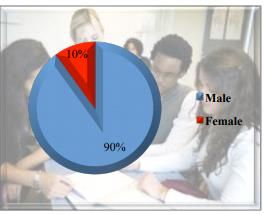
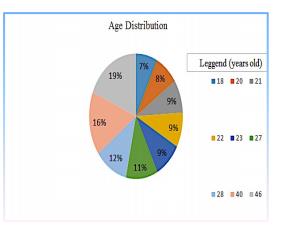
3. Findings and Discussion
Under this headline, the results of the two main constructs
experience is more pleasant when using gamification in the Economics’ learning process, compared to
the use of other aid tools for visualizing the information (partial ICT use or no ICT use)”, while 15%
have a neutral position (neither agree nor disagree).
About 85% of the students strongly agree (45% to a very large extend and 40% to a large extend)
with the statement that “It is more pleasant to assimilate Economics concepts when gamification is used,
compared to using the traditional teaching system”.
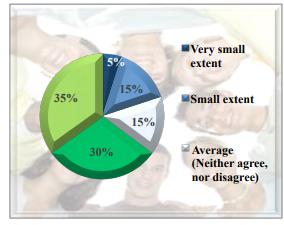
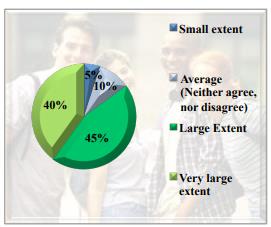
About 75% of the students find satisfactory the experience with using gamification in
Economics learning process, while 25% find it neutral. None of the participants found the experience
unsatisfactory.
agree (48%) that using gamification in teaching Economics enhanced their performance in assimilating
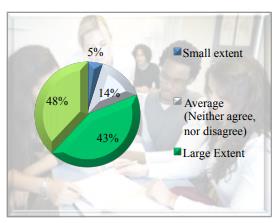
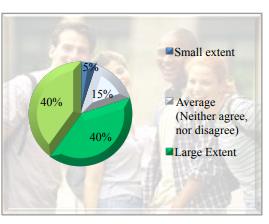
About 80% of the participants agree (40%) and strongly agree (40%) that
the teaching process determined a growth of interest for the Economics classes and an increase in the
the statement to a small extend.
3.1. Student experience
Students found the use of gamification as enjoyable and identified gamification as contributing
beneficially to learning Economics. Students were asked to motivate their position on the Likert scale
in relation to the addressed questions.
Questions addressing the impact of ICT in the learning process highlights:
participants find „unsatisfactory” the learning experience in classes while chalk and blackboard is used
as aid tool for visualising the information during lectures, while 40% find it neutral. While motivating
the answers for degree such as „unsatisfactory”, the following epithets are used by students to describe
the style: „antique” “obsolete”, „ monotonous” or „boring”. Students are also detailing reasons for their
believes: „the attention vanishes after a very short period of time”, „I can’t fix the information if the
dictation and writing speed is too high"; „attention goes away after a short time” . Students which find
this style satisfactory (20%) motivate their satisfaction with reasons such as „it’s an important tool for
teaching and learning”.
85% of participants find their experience satisfactory, while 5% are unsatisfied and 10% are unsure
about. Reasons motivating a high level of satisfaction include: „It stimulates my interest because I have
to think, not just to write like a robot”; „Interaction in the classroom is beneficial to a more effective
learning process compared to the classic style of teaching or „the most effective way of teaching and it
helps me to easily assimilate information", epithets associated with the degree of satisfaction being:
„Interactive” „catchy”
When it comes to the use of gamification in lecturing, 90% of the students finds this experience
„satisfactory”, the most frequently used epithet being „interactive”. Reasons for the high satisfaction
includes: “I paid attention to the classes and it was really a nice experience”, “it was an ingenious way
to make us better understand the topic", "a very effective and interactive way to get my attention".
Results displayed for (i) the two constructs at the core of this exploratory research
and perceived usefulness of Economics gamified learning activity in technical universities
gamification technique in Economics in technical students environment is an effective tool for
enhancing student engagement. Generation „Y” students exposed to the gamification experience -
instructiveness and dynamics in the learning process – suggests higher levels of involvement compared
to the learning process when other teaching methods are used.
More specific the results are very positive, particularly toward enhancing learning, which is one
of the primary objectives of the education. The majority of participants felt that the gamified learning
activity improved their learning. Furthermore, the activity did engage the participants and resulted in a
high degree of enjoyment.
Through these results the effectiveness of using gamification in teaching Economics in technical
universities has been signalled. The positive results of this explanatory research confirm for the
Romanian Generation Y students statements previously made in the literature about the teaching
methods with Generation Y students and further support the use of gamification in Economics classes
while demonstrating its effectiveness.
For the second category of relevant stakeholders of the higher education system in Romania,
this exploratory research provides an understanding of the Generation Y drivers for performance in
learning process.
Within the environment described at the beginning of this exploratory research, it was of
relevance to examine and understand the preferences of Millennials for the learning process for at least
two reasons: (i) provided orientation for the professors - on how to communicate effectively with the
students during the learning process; (ii) highlighted within a particular environment the importance of
accepting the features of an open higher education system.
Millennials or „digital native” generation are independent and they feel empowered by
technology. Incorporating gamification tools to support the teaching process in the class, further sustain
student engagement in learning when games used in the class can be further explored by students using
their own communication tools, which contribute to the effectives of the learning process.
4. Conclusions
Using gamification in teaching Economics for students enrolled with technical universities have
potential to increase student motivation.
As digital natives, students of generation „Y” expect the use of ICT in the classroom. For them
this is natural and therefore they feel attracted by collaborative, interactive and engaging learning
environment: they favour learning environments that incorporate ICT.
However, the results are self-reported within an exploratory research and refer to one particular
implementation of gamification in Economics classes with students within a technical university,
The results of this exploratory research demonstrate that this particular implementation of
gamification – in Economics classes with students from technical university - has beneficial effects, lay
the groundwork and invite for further research into the matter. Further research should be conducted to
secure the potential bias incorporated in the results and to determine other ways in which gamification
can be implemented in education.
Although our work is only one particular use of gamification in education, our results are
promising and other applications of gamification in education should be investigated since there is no
longer an option using old traditional teaching methods in a world of disruptive changes. While
acknowledging that introducing gamification can be difficult within an inertia context, it is a theme that
require\s attention at the level of Romanian higher education system .
Acknowledgements
We would like to thank the students participating in this survey - from the Faculty of Building Services - Technical University of Civil Engineering of Bucharest - for helping to address the consideration of gamification in Economics classes and for their involvement in this exploratory research.
References
- Black, A. (2010). Gen Y: Who they are and how they learn . Educational Horizons, 91-101.
- Christoph, S. K. (2010). Exploratory Case Study. În A. J. Mills, G. Durepos, & E. Wiebe,
- Encyclopedia of Case Study Research (pg. 372-374). SAGE Publications, Inc.
- Corvi, E., Bigi, A., & NG, G. (2007). The European Millennials versus the US Millennials: similarities
- and differences . Preluat de pe http://www.unibs.it/sites/default/files/ricerca/allegati/Paper68.pdf
- Davis, F. D., Bagozzi, R. P., & Warshaw, P. R. (1989). User acceptance of computer technology: A
- comparison of two theoretical models. Management Science, 35 (8), pg. 982-1003.
- Deterding, S., Dixon, D., Khaled, R., & Nacke, L. (2011). Gamification: Toward a Definition .
- Vancouver, Canada. Preluat de pe http://gamification-research.org/wp-
- content/uploads/2011/04/02-Deterding-Khaled-Nacke-Dixon.pdf
- Merriam-Webster's. (2014). Collegiate Dictionary. Preluat de pe http://www.merriam-
- webster.com/dictionary/gamification
- Muntean, C. I. (2011). Raising engagement in e-learning through gamification . Preluat de pe
- http://icvl.eu/2011/disc/icvl/documente/pdf/met/ICVL_ModelsAndMethodologies_paper42.pdf
- Nicholson, S. (2015). A RECIPE for Meaningful Gamification in "Gamification in Education and Business". În T. Reiners, & L. C. Wood, Gamification in Education and Business. Springer International Publishing.
- Pew Research Center. (2010, 2 24). Millennials: A Portrait of Generation Next. Washington DC.
- Preluat de pe http://www.pewsocialtrends.org/2010/02/24/millennials-confident-connectedopen-to-change/ Prensky, M. (2005/2006). Listen to the Natives (Vol. 63 (4)). Educational Leadership.
- Price, C. (2009). Why Don’t My Students Think I’m Groovy?
- Rodgers, C. (2002). Defining reflection: Another look at John Dewey Teachers College Record (Vol. 104 (4)). Teachers College Record.
- van Roy, R., & Zaman, B. (2016). Why Gamification Fails in Education – And How to Make it Successful. Introducing 9 Gamification Heuristics based on Self-Determination Theory. In Ma, M., & Oikonomou, A. (eds.), Serious Games and Edutainment Applications 2. United Kingdom: Springer-Verlag.
- Venkatesh, V., & Davis, F. D. (2000). A Theoretical Extension of the Technology Acceptance Model: Four Longitudinal Field Studies (Vol. 46 (2)). Management Science.
Copyright information

This work is licensed under a Creative Commons Attribution-NonCommercial-NoDerivatives 4.0 International License.
About this article
Publication Date
25 May 2017
Article Doi
eBook ISBN
978-1-80296-022-8
Publisher
Future Academy
Volume
23
Print ISBN (optional)
-
Edition Number
1st Edition
Pages
1-2032
Subjects
Educational strategies, educational policy, organization of education, management of education, teacher, teacher training
Cite this article as:
Simionescu, V., & Mascu, S. (2017). Using Gamification For Teaching Economics In Technical Higher Education: An Exploratory Research. In E. Soare, & C. Langa (Eds.), Education Facing Contemporary World Issues, vol 23. European Proceedings of Social and Behavioural Sciences (pp. 532-541). Future Academy. https://doi.org/10.15405/epsbs.2017.05.02.65

